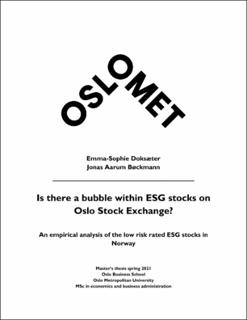| dc.description.abstract | The purpose of this master thesis is to examine whether there is a financial bubble within
ESG stocks on Oslo Stock Exchange. To research the thesis question, we apply both a
quantitative and a qualitative method. The main analysis is performed with a bubble model
proposed by Cuthbertson and Nitzsche (2004). The bubble model is based on a valuation
model including a bubble term. In the spirit of Anderson and Brooks (2014), the model is
further incorporated into a regression specification to perform statistical tests for the presence
of a bubble. In addition, we include bubble theory in the form of Shiller’s indicator list (2016) to
further analyze the ESG segment in the Norwegian stock market. The period studied extends
from 2015 to 2020.
We apply the bubble model to a constructed portfolio consisting of the 17 lowest ESG risk
rated stocks on Oslo Stock Exchange. In other words, we analyze the most sustainable and
green companies in the Norwegian financial market, provided by the database Sustainalytics.
An equally weighted portfolio is considered in the main analysis, while a value weighted
portfolio is used in a robustness check. The bubble model is approached with both a one- and
three-factor model based on research from Fama and French (1993), taking different
systematic risk factors into account. We obtain data consisting of monthly observations for
returns, dividend yields and market capitalizations from the 17 firms in the portfolio. The data
is collected from the Refinitiv database. When approaching Shiller’s indicator list, we study
empirical evidence based on the market environment in the Norwegian stock market.
The results from the regression for an equally weighted ESG portfolio provide support for the
bubble model, both in the one- and three-factor model. This indicates that there is a bubble
present in the data. Although, there is some uncertainty related to regression results. Taking
Schiller's indicator list into account, the general assessment points in the direction of a bubble.
Some of Schiller's criteria are ambiguous, but the overall analysis implies the presence of a
bubble in ESG stocks in the Norwegian market. Based on the results from both approaches,
we find evidence for our thesis statement being true; there is a bubble within ESG stocks on
Oslo Stock Exchange. | en_US |
